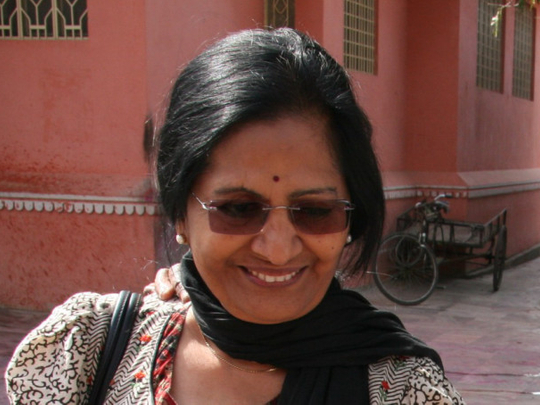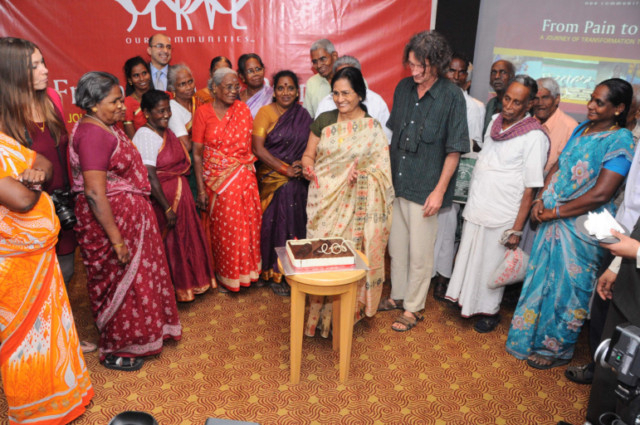
They fondly call her amma.
She embraces them warmly, listening to their chatter while chiding some of them for not putting in their best.
Like excited students they gather around her as they wait for the auction of their paintings to be held that evening. These students of Bindu Art School defy stereotypes, for they have been cured of leprosy and now let their imagination run riot while their deformed hands struggle to hold a brush.
And, unusual is the bond that they share with her — a bond born out of compassion. For these victims of leprosy condemned to a life of isolation and doom, Padma Venkataraman is a beacon of hope.
From hauling them from the dregs of poverty to giving them a life of dignity, Padma has been active in their rehabilitation over the past two decades. And, she does it quietly, shunning the glare of media.
At an age when most women relax with their grandchildren, this 70-year-old is busy coordinating with NGOs for the betterment of this ostracised section of society.
So what led her on this journey?
The eldest daughter of former president of India, late R. Venkataraman, Padma remembers the crowd of labourers waiting outside her house every morning and her father’s involvement in their welfare. Although she did not understand much then as a teenager, she did aspire to serve the less privileged some day.
That opportunity came to her much later in life following her marriage to Dr K. Venkataraman, an IAS officer. As the District Collector’s wife Padma became involved in social activities in Vellore, where her husband was posted initially.
And later when he moved to Vienna as Director, Unido (United Nations Industrial Development Organisation), Padma found herself espousing the rights and privileges of women as the founder of Women’s Indian Association. Besides being the permanent representative of All India Women’s Conference to the UN she served as vice-president and president of United Nations Women’s Guild.
The true calling came during a visit to Delhi in 1990. It was while travelling in a car that she noticed a leprosy-afflicted person begging for alms at a traffic signal.
“I did not want to encourage begging, so I did not give him alms,” she reminisces.
Yet the image of that beggar continued to nag her long after her return to Vienna. And it drove her back to Delhi within the next few months. Padma knew she wanted to work towards improving the lives of the people suffering from leprosy.
As a first step, she visited a “leprosy colony” along with few members of All India Women’s Conference.
“The residents of the colony were used to freebies doled out by charity organisations and expected the same from me. I made it clear that I had nothing to offer them but that I could help them to rebuild their lives if they were keen on learning income-generating skills,” Padma recalls.
Selling eatables was ruled out, since people would not consume products made by those who are afflicted by leprosy.
“Half-heartedly, they agreed to make home-cleaning liquids and detergents,” Padma says.
Shramik Vidyapeeth, a Government of India body, kick-started the project by imparting free training to 22 leprosy-affected persons. And, their products were marketed to hospitals, the Rashtrapati Bhavan (Indian president’s residence) and BHEL (Bharat Heavy Electricals Limited).
“Since these products were in constant demand, their sales improved,” Padma says. “Soon the residents of the leprosy colony became confident of themselves when they realised that they could become productive members of society.”
Posing a bigger challenge was Padma’s next project.
Shahdara, a colony spread across more than 60 hectares of land on the outskirts of Delhi, was home to 4000 leprosy-affected individuals.
“It was a mini-India, with people from all the states. When I first walked into this colony,” she says, “I was apprehensive. There was no water supply. Sanitary conditions were pathetic. Uneducated and jobless, most of them resorted to begging, peddling drugs and terrorising people in the neighbourhood. Even the police dreaded entering the colony.” That was 1990.
Over the next 18 months, as project director of this FAO-funded project, Padma was instrumental in transforming Shahdara. From improving water and sanitation to building a school for children and training their mothers to set up home ventures on microcredit, this project extended to developing an agricultural farm of about 8 hectares to be tended by trained leprosy-affected people. Other income-generating activities included pisciculture, welding and carpentry.
“The yield of wheat here surpassed national productivity level,” says Padma, an graduate in Economics.
The increase in food production provided the required nutritional value to the residents. Consequently, their health and quality of life perked up.
Houses for 800 families were designed by renowned architect Laurie Baker and constructed by HOPE Worldwide, a Philadelphia-based NGO. Shahdara was reborn as the “Village of Hope”.
The major achievement of this project was integration of the leprosy-affected people with neighbouring villages. Appreciating the sustainability of the project FAO recommended that this programme be implemented in other parts of India. Following this recommendation, Danida (Danish International Development Agency) came forward to fund a similar project in Tamil Nadu, and by 1995, Padma had settled back in her hometown, Chennai.
As honorary director, she spearheaded a Danida project between 1997 and 2003; it was supported by the Tamil Nadu state government and implemented by Women’s Indian Association. This project covered ten government-run homes and 31 colonies for people affected by leprosy. More than 36 hectares of wasteland were brought under cultivation. Diary units were set up. Twenty women from each home were trained in growing vegetables. A corpus fund was created in each home to ensure sustainability. “Introduction of microcredit was the most successful and innovative aspect of this project,” Padma says.
Today she juggles several roles. She is the president of Gnanodaya Rehabilitation Association that runs a school for children of leprosy-affected parents. She is trustee of Global Cancer Concern and patron of Gandhi Peace Foundation.
As co-initiator, she assisted Austrian artist Werner Dornik to start Bindu Art School in Bharatapuram leprosy colony. The students of this unique art school have all been cured of leprosy. They receive a monthly stipend for their work and share the profits from the sale of paintings. Running into its seventh year, Bindu Art School has showcased its work not only in India but also in the United States and Austria.
“Art has brought a change in their lives,” Padma says. “They no longer quarrel among themselves, nor do they complain about their health. Their minds are now creatively occupied.”
Padma is also board chairman of Rising Star Outreach, a US-based philanthropic organisation that runs a school for children of leprosy-affected parents.
“Of course, on this journey there were roadblocks and moments of frustration, but the rewarding moments surpass everything,” she says. “It was like challenging the challenged [those affected by leprosy] to prove that even they can become productive members of society,” says Padma, who is a recipient of the Hands of Hope Award and Enterprise Mentors International Humanitarian Award 2009.
What has been her family’s attitude to her work, you can’t help but ask. She smiles. “My father led by example. My mother was a compassionate woman who did things quietly,” she says, going on to narrate a particular incident: “It was during the time I was working in the colonies of Tamil Nadu. My parents had purchased a new car and they were ready to drive it to the temple for performing its puja. I did not want to use it that day, so I called for a cab to take me to the colonies. When my mother came to know of this, she told me, ‘Do take the new car. I don’t think there is a greater god in the temple than in those colonies.”
Lending her support has been her husband, who allows her to follow her heart — for Padma cherishes the words of Mahatma Gandhi: “Leprosy work is not merely medical relief; it is transforming frustration of life into joy of dedication and personal ambition into selfless service.”
Mythily Ramachandran is a writer based in Chennai, India.



